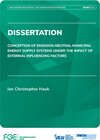Conception of Emission-neutral Municipal Energy Supply Systems Under the Impact of External Influencing Factors
von Jan Christopher Hauk, herausgegeben von Albert Univ.-Prof. Dr.-Ing. MoserThe national target of emission neutrality by 2045, defined by the German government, requires the decarbonization of energy supply in municipalities. This can be achieved through a number of measures such as efficient technologies like heat pumps, the installation of photovoltaic and solar thermal units, and the expansion of the heat grid. When designing municipal supply systems, different elements like energy conversion units and storages in buildings and at central locations as well as distribution grids for electricity, gas, and heat need to be considered. Between these elements, a number of dependencies exist, but also synergies and flexibilities can be utilized.
Municipal decision makers such as majors can therefore identify the most suitable system design to achieve emission-neutral energy supply by using an integrated and cross-carrier conception, so that all system elements and all energy carriers are considered. For a particular municipality, the most suitable system design can be influenced by a number of external factors such as the availability of energy carriers, their costs, or the progress of energy-saving building refurbishment measures.
The target of this thesis is therefore the development of an optimization procedure for the conception of municipal energy supply systems. The chosen approach optimizes the expansion and operational planning for energy conversion units, storages, and distribution grids for electricity, gas, and heat in an integrated approach. Grid expansion decisions are, with respect to fix investment costs, modeled using binary variables. Relevant aspects of heat supply such as time-varying heat pump efficiencies as well as losses in the heat grid are also considered.
The developed optimization procedure is applied to a case study municipality including around 1,900 buildings, assessing the impact of the four influencing factors „availability of pellets“, „availability of hydrogen or emission-neutral methane“, „costs of energy carriers“, and „building refurbishment“. The results for the studied municipality show, that across the various scenarios a multivalent energy supply system is chosen, which allows for flexibility by combiningdecentral and central conversion units and storages in combination with the energy carrier grids. This highlights the importance of an integrated and cross-carrier conception. As robust decisions in the studied municipality across nearly all scenarios, the installation of central ground water heat pumps in combination with the expansion of the heat grid for the provision of heat base load can be identified. Whenever possible, the heat grid is operated on a lower flow temperature level, which allows for a higher coefficient of performance of central heat pumps. To provide heat to not refurbished buildings, decentral pellet and hydrogen heaters are installed. Across all scenarios, decentral electric heaters are utilized to provide heat peak load. The assessment of the influencing factors shows the tendency of the municipal planner towards pellet-fi red conversion units. Furthermore, building refurbishmentsare identified as key enabler to decommission the gas distribution grid and to provide heat with high efficiency based on central heat pumps.
Municipal decision makers such as majors can therefore identify the most suitable system design to achieve emission-neutral energy supply by using an integrated and cross-carrier conception, so that all system elements and all energy carriers are considered. For a particular municipality, the most suitable system design can be influenced by a number of external factors such as the availability of energy carriers, their costs, or the progress of energy-saving building refurbishment measures.
The target of this thesis is therefore the development of an optimization procedure for the conception of municipal energy supply systems. The chosen approach optimizes the expansion and operational planning for energy conversion units, storages, and distribution grids for electricity, gas, and heat in an integrated approach. Grid expansion decisions are, with respect to fix investment costs, modeled using binary variables. Relevant aspects of heat supply such as time-varying heat pump efficiencies as well as losses in the heat grid are also considered.
The developed optimization procedure is applied to a case study municipality including around 1,900 buildings, assessing the impact of the four influencing factors „availability of pellets“, „availability of hydrogen or emission-neutral methane“, „costs of energy carriers“, and „building refurbishment“. The results for the studied municipality show, that across the various scenarios a multivalent energy supply system is chosen, which allows for flexibility by combiningdecentral and central conversion units and storages in combination with the energy carrier grids. This highlights the importance of an integrated and cross-carrier conception. As robust decisions in the studied municipality across nearly all scenarios, the installation of central ground water heat pumps in combination with the expansion of the heat grid for the provision of heat base load can be identified. Whenever possible, the heat grid is operated on a lower flow temperature level, which allows for a higher coefficient of performance of central heat pumps. To provide heat to not refurbished buildings, decentral pellet and hydrogen heaters are installed. Across all scenarios, decentral electric heaters are utilized to provide heat peak load. The assessment of the influencing factors shows the tendency of the municipal planner towards pellet-fi red conversion units. Furthermore, building refurbishmentsare identified as key enabler to decommission the gas distribution grid and to provide heat with high efficiency based on central heat pumps.






